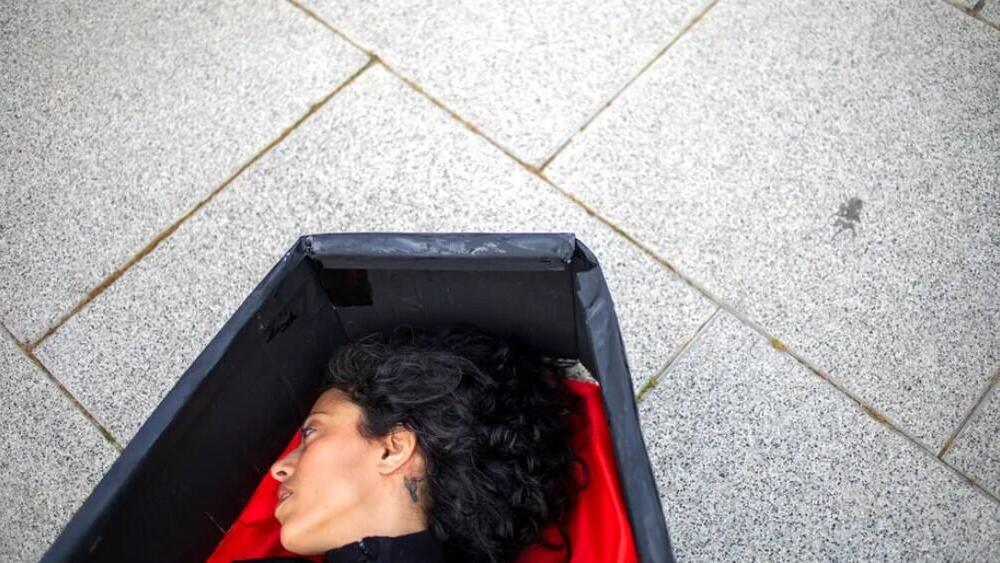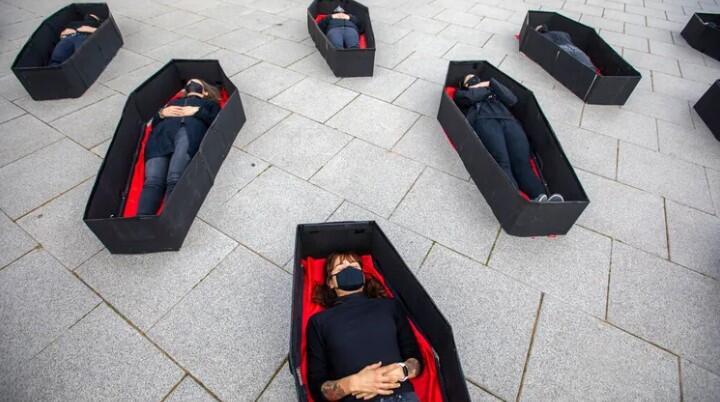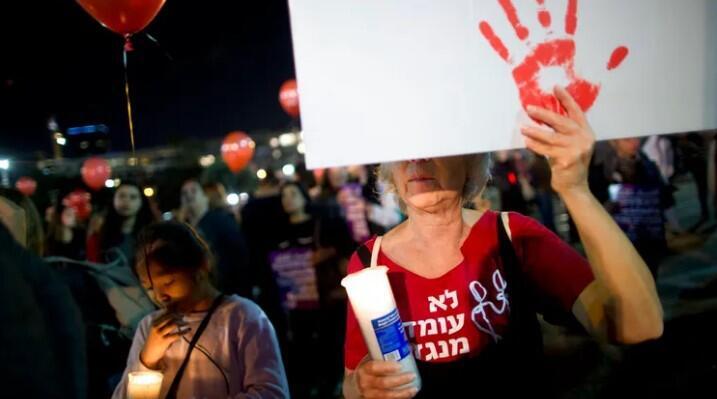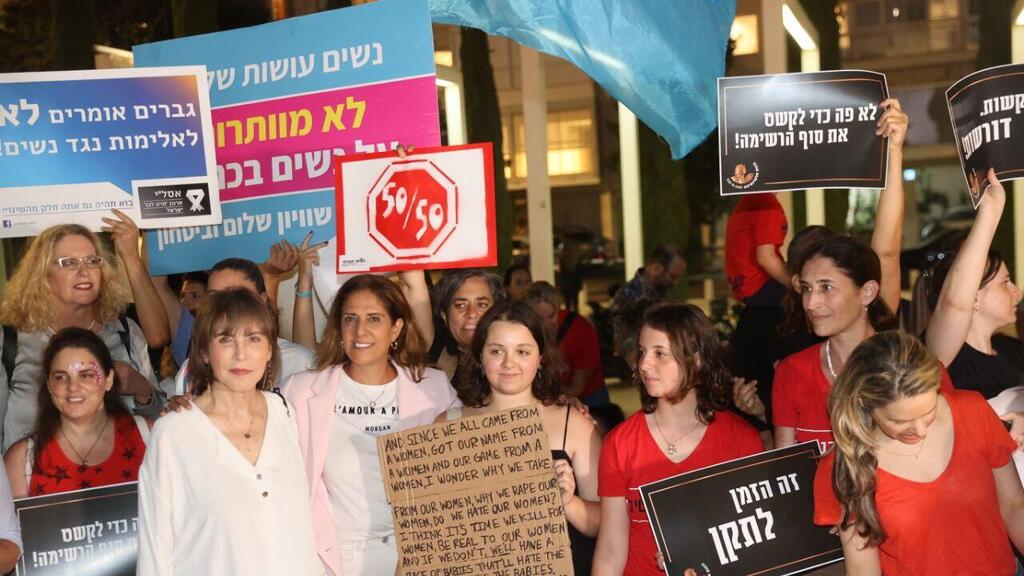Getting your Trinity Audio player ready...
In 2022, Israel saw the rate of femicide increase by 50 percent from the year before, according to the Israel Observatory on Femicide (IOF), despite an increased sense of awareness and amid what is considered a lack of mobilization to address the "frightening trend."
According to an IOF report, 24 women were murdered last year in the Jewish state “because they were women," up from 16 in 2021. Half of those women killed were in Israel’s Arab sector – which only makes up 21 percent of Israel’s total population.
4 View gallery


A woman lays in a coffin representing women killed in domestic violence in front of Tel Aviv
(Photo: AP)
“After a decrease in 2021, this year there is a significant rise in the number of femicide cases in Israel in which a woman is killed because of her gender,” said Shalva Weil, who established the IOF and is a senior researcher at the Seymour Fox School of Education of Hebrew University in Jerusalem.
“We must stop the violence and eradicate this frightening trend.”
Femicide is defined as the intentional killing of women because they are female. Accordingly, the number of women murdered for other reasons – such as accidental murder or involvement in crime – were omitted from IOF’s findings. Some femicide cases in Israel are still under investigation while a number of women have restraining orders in effect.
Weil noted that the COVID pandemic and the national lockdowns as counter-measures played a significant role in the fluctuation of femicide trends in Israel, as well as around the world, over the last few years.
“In 2020 with COVID and lockdowns, women were released from shelters and went back home to their violent partners. Or prisoners with a violent record were released and sent home because of COVID, and within weeks there were dead women," she said, referring to when Israel's government approved an emergency regulation in March 2020 to release some 400 offenders from prisons throughout the country for 30-day houses arrests to curb the spread of the virus.
"But in 2021, lockdowns had finished in Israel, and everybody was happy going outside, so the rate of femicide dropped.”
Half of all femicide victims last year in Israel were Jewish, and half were Israeli-Arabs, including Druze, Bedouin, Christian Arabs, and Muslims.
"It appears that society is becoming more violent, and there has certainly been more violence in the Arab sector," Weil noted. There has been a rise in crime and violence in Israel's Arab communities over the years. Far fewer murder cases of Arab women are solved by the Israeli Police than femicides of Jewish Israeli victims, the IOF report stated.
But despite the trend being a concerning phenomenon in Israel, the rate of it is far better than anywhere else, including in the United States and many countries in Europe, Weil said.
“Israel has far fewer femicides per capita than most countries. As for the femicide rate in the Middle East or north Africa, it’s hard to tell because data isn’t always accurate or even existent there. But my hunch is that the rate is much lower in Israel than its surrounding region.”
“Here, there’s a new consciousness about femicide. When I started researching this phenomenon in 2008, nobody in Israel cared. But now everyone is reporting on it with a whole new awareness, and each victim is mentioned by name," she continued.
According to the IOF's latest report:
In 79 percent of the cases, the victim knew the murderer/suspect, and 58 percent of the cases were intimate partner femicides, instigated by jealousy or were "honor killings" – the murder of an individual by someone seeking to protect what they see as the dignity and honor of themselves or their family.
“It’s not necessarily only misogynists that do this, it’s mostly males that are obsessive or strongly resent their partners and get violent," said Weil.
The average age of victims was just over 38 years old. The youngest victim was 14, and the oldest was 68. The average age of the suspect/murderer suspect was 39, while the youngest was 19 and the oldest 65.
38 percent of the victims were stabbed to death, and 25 percent were shot with a gun. The rest of the cases involved the use of an explosive device, drowning, hanging, and the use of substances.
In a third of cases, the suspect was known to the police or welfare authorities from previous violent incidents. In other cases, the murderer was known to have a criminal or mental health record.
“A lot can be done," Weil urged. "The fact my Observatory is independent, and that I had to beg for finances to carry out basic work monitoring femicide is pathetic. I’ve been invited by Georgia’s president to set up an observatory there, and I established the European Observatory on Femicide in Malta. Israel doesn't even have a government department that supports institutions like mine.”
“The government could also support more programs," she continued. "There are women’s shelters, but no men’s shelters. When a man attacks a woman, the woman has to leave for a shelter. Why not set up shelters, or even treatment centers for violent men? Why do the women have to leave their homes?”
Data gathered by the IOF came from local and national media, internet reports, Google alerts, interviews, and reports from women’s organizations. Findings were cross-checked with other databases from different NGOs and parliamentary reports, and do not rely solely on official police data.
The IOF aims to be Israel’s official body providing qualitative and quantitative data in an objective manner on femicide from the beginning of the year until the end. For the first time, the report was distributed in English, Hebrew, and Arabic.




